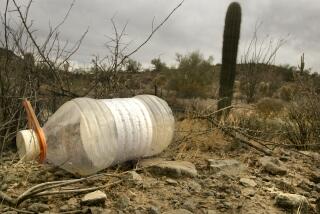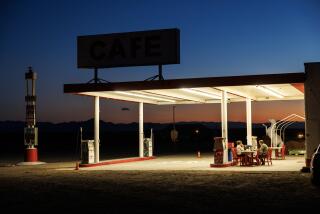Bagdad Fades Into the Desert--in California
- Share via
BAGDAD, Calif. — Ever since Iraq invaded Kuwait, curious motorists passing through the Mojave Desert have stopped to ask the way to Bagdad, the California ghost town named in the 1800s for the Middle Eastern capital.
“Every day they come into our gas station or restaurant and ask, ‘Where’s Bagdad? We can’t find it,’ ” said Buster Burris, 81, owner of the town of Amboy, population 27, eight miles east of where maps indicate Bagdad is located.
Burris tells them Bagdad is but a memory these days.
Situated in the middle of the desert, Bagdad is 75 miles southeast of Barstow on old Route 66 in a long valley between the Bristol and Bullion mountains.
Today, its only inhabitants are snakes, lizards, scorpions, pack rats and an assortment of other wildlife. There’s a lone palm tree, half a dozen scraggly salt cedars and a scattering of sagebrush growing in the desert sand.
Bagdad has always been one of the driest places in the United States. It recorded the longest period of drought anywhere in the history of the country from July, 1912, to November, 1914: 767 consecutive days without precipitation.
There is an eerie quiet here that is broken from time to time by the 30 to 40 trains that rumble through Bagdad each day.
In 1883, railroad officials who dubbed two nearby settlements Siberia and Klondike named this desert town after the Iraqi capital, omitting the “h” in a divergent spelling for the city on the Tigris. As many as 50 Chinese railroad workers died while laying tracks, falling victim to a cholera epidemic. An unmarked burial ground is believed to be somewhere nearby.
A “Bagdad” sign, along the mainline Santa Fe tracks marks the site of the town that boomed from the late 1800s through the early 1900s, finally gasping its last breath in the late 1960s.
Bagdad was an important railhead, a watering place for railroad engines during steam days and a center for nearby gold, silver, copper and lava mining camps--for mines such as the Orange Blossom, War Eagle and Lady Lou.
There were homes, hotels, saloons and stores here, a post office from 1889 to 1923, a school, a passenger railway station and a Harvey House restaurant. By the 1940s, however, all that remained was the depot, a few homes, the Bagdad Cafe, a gas station and cabins for overnight stays on U.S. 66.
Its population dwindled from a few hundred during its heyday to fewer than 20 in the mid-1940s, when Paul Limon worked here pumping gas at 23 cents a gallon. Limon, now 63, lives in Cadiz, 20 miles east of Bagdad. He recalled the town as he knew it during the 1940s and 1950s:
“Bagdad was a lively little place. People from all over the desert would come here because of the Bagdad Cafe, owned and operated by a woman named Alice Lawrence. The Bagdad Cafe was the only place for miles around with a dance floor and juke box.
“The Bagdad Cafe was a happy-go-lucky, popular spot. When I hear or read about the war in the Persian Gulf and Baghdad is mentioned, I think about Bagdad, Calif., and all the good times I had in this town,” Limon said during a sentimental visit here. Many who drove U.S. 66, America’s main street from the Midwest to California, will remember Bagdad, allowed Limon.
“Overheated cars from every state would stop to get water. Cars in those days were always boiling over. And a lot of those people ate in the Bagdad Cafe.”
In fact, the town served as the original inspiration for the 1988 movie and subsequent television program, “Bagdad Cafe”--which was actually filmed at the Sidewinder Cafe in Newberry Springs, 40 miles to the northwest.
Percy Adlon, 55, a German film producer and founder of the Pelemele Film Corp., said he and his wife were driving in the desert in 1985 and, noticing Bagdad on the map, went off in search of the town.
They never did find it, but the name intrigued Adlon so much that he produced a film about “a Bavarian lady stranded in the desert in a cafe next to a dusty hotel,” he said Wednesday in an interview. A CBS series that spun off the film starred Whoopie Goldberg and Jean Stapleton and ran 19 episodes before it was canceled in November.
Bagdad was bypassed in 1972 when Interstate 40 opened 20 miles to the north and the two-lane stretch of Route 66 through here became a deserted, seldom-used road.
But Bagdad had died years before the freeway opened. And the cafe, depot and what few structures remained were destroyed by vandals.
A network of dirt streets outline the town that was. Two speed-limits signs--15 m.p.h.--still stand. Concrete building foundations, rusted automotive parts, mining equipment and pipes, shattered glass and dinnerware, old pots and pans and other debris litter the area.
“This is where the Bagdad Cafe and gas station were,” said Limon, standing on what is left of the eatery--the front steps.
He drove over the dirt streets to the old Bagdad Cemetery, a handful of graves marked with weathered crosses with names no longer legible. Signs were evident that grave robbers had recently desecrated the final resting place of Bagdad residents who died here in the late 1800s and early 1900s.
“This really sickens me,” sighed Limon, as he looked down at holes dug at two of the grave sites.
More to Read
Sign up for Essential California
The most important California stories and recommendations in your inbox every morning.
You may occasionally receive promotional content from the Los Angeles Times.










